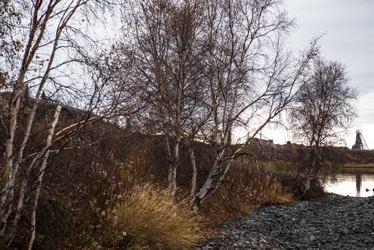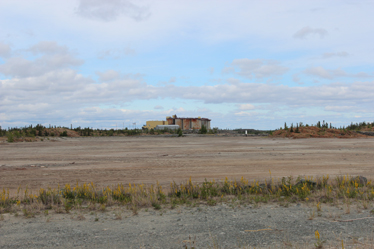Giant Mine: remediating the surface
After remediation, the Giant Mine landscape will change.
On this page
Future use of the site
Following remediation of Giant Mine, the landscape will be different. Mine buildings will be gone and some areas will have new industrial structures, like the freeze systems and a water treatment plant. There will also be a rock cover on the tailings ponds and Baker Creek will run along a slightly different route.

The central area of the site will not be available for public use. This includes, including areas around the:
- frozen arsenic chambers
- water treatment plant
- non-hazardous landfill
However, a large part of the site could be available for different activities. To help find out how the community wants to use the area in future, the Project team carried out a surface design engagement process. The Project team shared this information with the City of Yellowknife and the Government of the Northwest Territories, who are responsible for decisions about the use of areas outside the central, restricted area.
Surface remediation plan updates
The Project team updated the surface remediation plan to address measures that came out of the environmental assessment. This plan looks at the Giant Mine surface, including:
As a part of updating the surface remediation plan, the Project team considered possible uses for the site after remediation. This includes what the Giant Mine site will look like and how later generations could use this area.
In 2015 and 2016, through a surface design engagement process, the team engaged the public to answer these questions. The process was developed with extensive input from:
- the Giant Mine Working Group
- the Giant Mine Advisory Committee
In addition to the Project team, engagement participants included representatives from:
- Yellowknives Dene First Nation
- North Slave Métis Alliance
- City of Yellowknife
- Giant Mine Oversight Board
- Alternatives North
- Environment and Climate Change Canada (then Environment Canada)
- Fisheries and Oceans Canada
- Health Canada
- Fly Kid Foundation
- Yellowknife Historical Society (then Mine Heritage Society)
- Great Slave Sailing Club
The Surface Design Engagement process was made up of a series of multi-day workshops, meetings and information-sharing events with many rights holders and stakeholders over 2 years.
Participants provided direct input into planning for the surface remediation by developing and evaluating remediation options based on their objectives for the site. The process needed a significant time commitment from participants. The Project team gave the outcomes of these meetings careful consideration as they finalized the Closure and Reclamation Plan.
Knowing how the public imagines the site once remediation is complete helped the team make more detailed plans for specific site elements. While the final plan may not reflect everybody's vision for the surface, the process allowed the Project team to understand the many perspectives they must consider in preparing the plan. Below is summary of how the Project will remediate the surface elements of the site.
Buildings
There are currently approximately 85 buildings on the site. This includes those at the Giant Mine town site. Industry best practices requires the disposal all buildings and infrastructure that no longer serve a purpose.

Many of the buildings on site contain hazardous materials. These materials pose health and safety risks to workers and the environment during demolition. Therefore, most of the buildings require decontamination prior to deconstruction.
The materials left over from the roaster deconstruction are heavily contaminated with arsenic. These materials will be placed underground and frozen as part of the freeze area. Hazardous materials such as leachable lead paint and PCB-containing items will be shipped off-site to licensed facilities for disposal. Non-hazardous material such as wood, steel, and mechanical equipment will be disposed in an on-site, engineered non-hazardous waste landfill.
Some infrastructure work has already taken place to reduce health and safety risks. For additional details, consult the Risks addressed to date page.
Tailings
The Giant Mine tailings are milled and finely crushed rock leftover from separating gold from ore-bearing rock. There are 4 tailings ponds on site that together contain approximately 16 million tonnes of tailings. These cover about 95 hectares, or the size of 300 football fields. There's also a section of historic tailings on the shores of Great Slave Lake.
Some of these tailings were mixed with water and cement to form a paste. This paste was used to stabilize portions of the underground. The rest of the tailings will be relocated or covered during remediation.

The surface design engagement process included several options for tailings that were evaluated by participants based on their objectives. Options included:
- relocating tailings or capping in place
- vegetated or rock cover over the tailings
The Surface Design Engagement report summarizes stakeholder input, for consideration by the Project team, including input on addressing tailings. For a copy of the report or more information, contact the Project team.
The final plan for tailings will include relocating the South tailings ponds to the Central and North tailings ponds. These 2 ponds, along with the Northwest tailings pond, will be capped with a geo-synthetic and rock cover.
Pits
There are 8 open pits on the mine site. Of these, 5 are large. Together, these 5 pits have the capacity to hold 860 Olympic-sized swimming pools. The surface design engagement process evaluated the following options for pits:
- leaving the pits open with a fence to prevent access
- filling the pits with materials such as:
- clean rock
- contaminated soils
- tailings
The final plan will involve filling the pits with a combination of coarse waste rock and gravel material. This decision considered stakeholder feedback.
One of the pits sits on top of 2 chambers that contain arsenic trioxide waste. This pit will also be filled to allow the project to freeze these 2 chambers, along with the pit fill material.
There are also some quarries and borrow pits. These will be re-sloped to improve drainage and stability, to reduce physical hazards and return the site to more natural conditions.
Contaminated soils and waste rock
The Project team is finalizing plans on how to address contaminated soils, including arsenic-impacted soil and waste rock around the mine site. The most heavily impacted soils are found around the former roaster and mill area. This material will be disposed of underground in the freeze areas.
The Surface Design Engagement process considered various options for cleaning up the soils. The Project team will consider potential future land uses when making decisions in the final surface plan for soils and waste rock in order to minimize impacts to the environment and human health.
Baker Creek
Various sections of Baker Creek have been modified, relocated or reconstructed over the course of Giant Mine's history.
The latest relocation was done in summer 2006. It prevented infiltration of creek water into the mine. As part of the environmental assessment measures, the Project team was asked to examine if Baker Creek should be diverted off-site.
The project team consulted with community members and stakeholders through the surface design engagement process. After completing a Baker Creek realignment report, it was confirmed that Baker Creek will stay on site, instead of being realigned to move off the site, as part of the final remediation plan.
The project team will remediate Baker Creek by removing contaminated sediments and minimizing the risk of flooding to the underground by:
- building an appropriately-sized channel
- filling the open pits
Due to historical impacts from the roaster emissions, waterbodies upstream of Baker Creek were impacted. As a result, water quality will continue to be impacted on-site. It's also likely that eating fish from Baker Creek will be discouraged for many years, even after remediation is complete.
Future use of the site
The City of Yellowknife and the Government of the Northwest Territories will decide how to use the site after remediation. But, the Project team sought to understand what the public envisions and for the City and Government of the Northwest Territories to consider while the team developed the Closure and Reclamation Plan.
The final report on the surface design engagement was finished in September 2016.
The report:
- summarizes feedback from the workshops
- documents the result of the workshops
- documents input received throughout the engagement process
It's been distributed to stakeholders. If you want to get a copy of the report, email the Project team or call 867-669-2426.